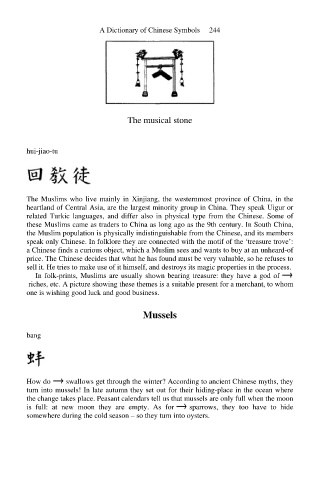Page 251 - A Dictionary of Chinese Symbols BIG Book
P. 251
A Dictionary of Chinese Symbols 244
The musical stone
Muslims
hui-jiao-tu
The Muslims who live mainly in Xinjiang, the westernmost province of China, in the
heartland of Central Asia, are the largest minority group in China. They speak Uigur or
related Turkic languages, and differ also in physical type from the Chinese. Some of
these Muslims came as traders to China as long ago as the 9th century. In South China,
the Muslim population is physically indistinguishable from the Chinese, and its members
speak only Chinese. In folklore they are connected with the motif of the ‘treasure trove’:
a Chinese finds a curious object, which a Muslim sees and wants to buy at an unheard-of
price. The Chinese decides that what he has found must be very valuable, so he refuses to
sell it. He tries to make use of it himself, and destroys its magic properties in the process.
In folk-prints, Muslims are usually shown bearing treasure: they have a god of
riches, etc. A picture showing these themes is a suitable present for a merchant, to whom
one is wishing good luck and good business.
Mussels
bang
How do swallows get through the winter? According to ancient Chinese myths, they
turn into mussels! In late autumn they set out for their hiding-place in the ocean where
the change takes place. Peasant calendars tell us that mussels are only full when the moon
is full: at new moon they are empty. As for sparrows, they too have to hide
somewhere during the cold season – so they turn into oysters.

